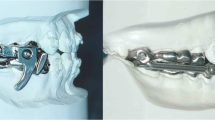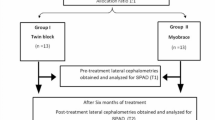Abstract
Objectives
Purpose of the present study was to determine and compare possible changes in the dimensions of the pharyngeal airway, morphology of the soft palate, and position of the tongue and hyoid bone after single-step or stepwise mandibular advancement using the Functional Mandibular Advancer (FMA).
Patients and methods
The sample included 51 peak-pubertal Class II subjects. In all, 34 patients were allocated to two groups using matched randomization: a single-step mandibular advancement group (SSG) and a stepwise mandibular advancement group (SWG). Both groups were treated with FMA followed by fixed appliance therapy; the remaining 17 subjects who underwent only fixed appliance therapy constituted the control group (CG). The study was conducted using pre- and posttreatment lateral cephalometric radiographs. Data were analyzed by paired t test, one-way analysis of variance, and Pearson’s correlation coefficient.
Result
In the SWG and SSG, although increases in nasopharyngeal airway dimensions were not significant compared with those in the CG, enlargements in the oropharyngeal airway dimensions at the level of the soft palate tip and behind the tongue, and decreases in soft palate angulation, were significant. Tongue height increased significantly only in the SWG. Compared with the CG, while forward movement of the hyoid was more prominent in SSG and SWG, the change in the vertical movement of the hyoid was not significant. No significant difference between SWG and SSG was observed in pharyngeal airway, soft palate, tongue or hyoid measurements.
Conclusions
The mode of mandibular advancement in FMA treatment did not significantly affect changes in the pharyngeal airway, soft palate, tongue, and hyoid bone.
Zusammenfassung
Zielsetzung
Ziel der Arbeit war die Überprüfung möglicher Veränderungen hinsichtlich der Dimensionen der pharyngealen Luftwege, der Morphologie des weichen Gaumens sowie der Position von Zunge und Os hyoideum nach einzeitiger bzw. mehrschrittiger Unterkiefervorverlagerung mittels Functional Mandibular Advancer (FMA).
Patienten und Methoden
Das Studienkollektiv bestand aus 51 Klasse-II-Patienten im pubertären Wachstumsmaximum. Insgesamt 34 Patienten wurden mittels gematchter Randomisierung 2 Gruppen zugeteilt: Gruppe 1 mit einschrittiger (“single-step mandibular advancement group”, SSG) und Gruppe 2 mit schrittweiser Unterkiefervorverlagerung (“stepwise mandibular advancement group”, SWG). In beiden Gruppen wurde mit FMA und anschließender festsitzender Apparatur behandelt. Die 17 Patienten, die nur mit einer festsitzenden Apparatur behandelt wurden, dienten als Kontrollgruppe (“control group”, CG). Untersucht wurden Fernröntgenseitenbilder vor und nach Behandlung; die Evaluierung der Daten erfolgte mit gepaartem t-Test, einfaktorieller Varianzanalyse und dem Korrelationskoeffizienten nach Pearson.
Ergebnisse
Die Erweiterungen im Bereich des Nasopharyngealraums waren nach SWG und SSG im Vergleich zu CG nicht signifikant. Vergrößerungen des oropharyngealen Luftwegs auf Höhe der Spitze des weichen Gaumens und hinter der Zunge sowie die Verringerungen der Angulierung des weichen Gaumens erwiesen sich als signifikant. Nur in der SWG-Gruppe änderte sich die Höhe der Zunge signifikant. Während die Bewegung des Os hyoideum nach anterior im Vergleich zur CG in den Gruppen SSG und SWG deutlicher war, erwies sich die Änderung in der vertikalen Bewegung des Os hyoideus als nicht signifikant. Zwischen den Gruppen SWG und SSG wurden keine signifikanten Unterschiede im Hinblick auf den pharyngealen Raum, den weichen Gaumen, die Zunge oder das Hyoid beobachtet.
Schlussfolgerung
Die Art der Unterkiefervorverlagerung mit der FMA-Apparatur hatte keinen signifikanten Effekt in Hinblick auf den pharyngealen Luftweg, weichen Gaumen, Zunge und Os hyoideum.


Similar content being viewed by others
References
Aras I, Pasaoglu A, Olmez S, Unal I, Tuncer AV, Aras A (2016) Comparison of stepwise vs single-step advancement with the functional mandibular advancer in Class II Division 1 treatment. Angle Orthod. doi:10.2319/032416-241.1
Bavbek NC, Tuncer BB, Turkoz C, Ulusoy C, Tuncer C (2015) Changes in airway dimensions and hyoid bone position following class II correction with forsus fatigue resistant device. Clin Oral Investig. doi:10.1007/s00784-015-1659-1
Chen Y, Hong L, Wang CL, Zhang SJ, Cao C, Wei F et al (2012) Effect of large incisor retraction on upper airway morphology in adult bimaxillary protrusion patients. Angle Orthod 82:964–970
Chung DH, Hatch JP, Dolce C, Van Sickels JE, Bays RA, Rugh JD (2001) Positional change of the hyoid bone after bilateral sagittal split osteotomy with rigid and wire fixation. Am J Orthod Dentofac Orthop 119:382–389
Cozza P, Baccetti T, Franchi L, De Toffol L, McNamara JA Jr (2006) Mandibular changes produced by functional appliances in Class II malocclusion: a systematic review. Am J Orthod Dentofac Orthop 129(599):e1–12
Eggensperger N, Smolka K, Johner A, Rahal A, Thuer U, Iizuka T (2005) Long-term changes of hyoid bone and pharyngeal airway size following advancement of the mandible. Oral Surg Oral Med Oral Pathol Oral Radiol Endod 99:404–410
Feng X, Li G, Qu Z, Liu L, Nasstrom K, Shi XQ (2015) Comparative analysis of upper airway volume with lateral cephalograms and cone-beam computed tomography. Am J Orthod Dentofac Orthop 147:197–204
Germec-Cakan D, Taner T, Akan S (2011) Uvulo-glossopharyngeal dimensions in non-extraction, extraction with minimum anchorage, and extraction with maximum anchorage. Eur J Orthod 33:515–520
Ghodke S, Utreja AK, Singh SP, Jena AK (2014) Effects of twin-block appliance on the anatomy of pharyngeal airway passage (PAP) in class II malocclusion subjects. Prog Orthod 15:68
Godt A, Koos B, Hagen H, Goz G (2011) Changes in upper airway width associated with Class II treatments (headgear vs activator) and different growth patterns. Angle Orthod 81:440–446
Graber LW, Vanarsdall RL, Vig KWL (2012) Orthodontics: current principles and techniques. Elsevier/Mosby, Philadelphia
Hagg U, Taranger J (1980) Skeletal stages of the hand and wrist as indicators of the pubertal growth spurt. Acta Odontol Scand 38:187–200
Han S, Choi YJ, Chung CJ, Kim JY, Kim KH (2014) Long-term pharyngeal airway changes after bionator treatment in adolescents with skeletal Class II malocclusions. Korean J Orthod 44:13–19
Hanggi MP, Teuscher UM, Roos M, Peltomaki TA (2008) Long-term changes in pharyngeal airway dimensions following activator-headgear and fixed appliance treatment. Eur J Orthod 30:598–605
Iwasaki T, Takemoto Y, Inada E, Sato H, Saitoh I, Kakuno E et al (2014) Three-dimensional cone-beam computed tomography analysis of enlargement of the pharyngeal airway by the Herbst appliance. Am J Orthod Dentofac Orthop 146:776–785
Jena AK, Singh SP, Utreja AK (2013) Effectiveness of twin-block and Mandibular Protraction Appliance-IV in the improvement of pharyngeal airway passage dimensions in Class II malocclusion subjects with a retrognathic mandible. Angle Orthod 83:728–734
Johnston CD, Richardson A (1999) Cephalometric changes in adult pharyngeal morphology. Eur J Orthod 21:357–362
Kandasamy S, Goonewardene M (2014) Class II malocclusion and sleep-disordered breathing. Semin Orthod 20:316–323
Kinzinger G, Czapka K, Ludwig B, Glasl B, Gross U, Lisson J (2011) Effects of fixed appliances in correcting Angle Class II on the depth of the posterior airway space: FMA vs. Herbst appliance—a retrospective cephalometric study. J Orofac Orthop 72:301–320
Kinzinger G, Ostheimer J, Forster F, Kwandt PB, Reul H, Diedrich P (2002) Development of a new fixed functional appliance for treatment of skeletal class II malocclusion first report. J Orofac Orthop 63:384–399
Li L, Liu H, Cheng H, Han Y, Wang C, Chen Y et al (2014) CBCT evaluation of the upper airway morphological changes in growing patients of class II division 1 malocclusion with mandibular retrusion using twin block appliance: a comparative research. PLoS One 9:e94378
Lin Y-C, Lin H-C, Hung-Huey T (2011) Changes in the Pharyngeal airway and position of the hyoid bone after treatment with a modified bionator in growing patients with retrognathia. J Exp Clin Med 3:93–98
Maciel Santos ME, Rocha NS, Laureano Filho JR, Ferraz EM, Campos JM (2009) Obstructive sleep apnea-hypopnea syndrome—the role of bariatric and maxillofacial surgeries. Obes Surg 19:796–801
Malkoc S, Usumez S, Nur M, Donaghy CE (2005) Reproducibility of airway dimensions and tongue and hyoid positions on lateral cephalograms. Am J Orthod Dentofac Orthop 128:513–516
Martin SE, Mathur R, Marshall I, Douglas NJ (1997) The effect of age, sex, obesity and posture on upper airway size. Eur Respir J 10:2087–2090
Ozbek MM, Memikoglu TU, Gogen H, Lowe AA, Baspinar E (1998) Oropharyngeal airway dimensions and functional-orthopedic treatment in skeletal Class II cases. Angle Orthod 68:327–336
Ozdemir F, Ulkur F, Nalbantgil D (2014) Effects of fixed functional therapy on tongue and hyoid positions and posterior airway. Angle Orthod 84:260–264
Pirila-Parkkinen K, Lopponen H, Nieminen P, Tolonen U, Paakko E, Pirttiniemi P (2011) Validity of upper airway assessment in children: a clinical, cephalometric, and MRI study. Angle Orthod 81:433–439
Rama AN, Tekwani SH, Kushida CA (2002) Sites of obstruction in obstructive sleep apnea. Chest 122:1139–1147
Restrepo C, Santamaria A, Pelaez S, Tapias A (2011) Oropharyngeal airway dimensions after treatment with functional appliances in class II retrognathic children. J Oral Rehabil 38:588–594
Rizk S, Kulbersh VP, Al-Qawasmi R (2015) Changes in the oropharyngeal airway of Class II patients treated with the mandibular anterior repositioning appliance. Angle Orthod. doi:10.2319/042915-295.1
Schendel SA, Jacobson R, Khalessi S (2012) Airway growth and development: a computerized 3-dimensional analysis. J Oral Maxillofac Surg 70:2174–2183
Schutz TC, Dominguez GC, Hallinan MP, Cunha TC, Tufik S (2011) Class II correction improves nocturnal breathing in adolescents. Angle Orthod 81:222–228
Schwab RJ (1998) Upper airway imaging. Clin Chest Med 19:33–54
Torgerson D, Torgerson C (2008) Designing randomized trials in health, education and social sciences. Palgrave Macmillan, London
Ulusoy C, Canigur Bavbek N, Tuncer BB, Tuncer C, Turkoz C, Gencturk Z (2014) Evaluation of airway dimensions and changes in hyoid bone position following class II functional therapy with activator. Acta Odontol Scand 72:917–925
Villa MP, Miano S, Rizzoli A (2012) Mandibular advancement devices are an alternative and valid treatment for pediatric obstructive sleep apnea syndrome. Sleep Breath 16:971–976
Vizzotto MB, Liedke GS, Delamare EL, Silveira HD, Dutra V, Silveira HE (2012) A comparative study of lateral cephalograms and cone-beam computed tomographic images in upper airway assessment. Eur J Orthod 34:390–393
Yassaei S, Tabatabaei Z, Ghafurifard R (2012) Stability of pharyngeal airway dimensions: tongue and hyoid changes after treatment with a functional appliance. Int J Orthod Milwaukee 23:9–15
Author information
Authors and Affiliations
Corresponding author
Ethics declarations
Conflict of interest
I Aras, A. Pasaoglu, S. Olmez, I. Unal, and A. Aras declare that there are no competing interests. All procedures performed in studies involving human participants were in accordance with the ethical standards of the institutional and/or national research committee and with the 1964 Helsinki declaration and its later amendments or comparable ethical standards. Informed consent was obtained from all individual participants included in the study.
Additional information
Isil Aras: Dr.
Rights and permissions
About this article
Cite this article
Aras, I., Pasaoglu, A., Olmez, S. et al. Upper airway changes following single-step or stepwise advancement using the Functional Mandibular Advancer. J Orofac Orthop 77, 454–462 (2016). https://doi.org/10.1007/s00056-016-0062-0
Received:
Accepted:
Published:
Issue Date:
DOI: https://doi.org/10.1007/s00056-016-0062-0




